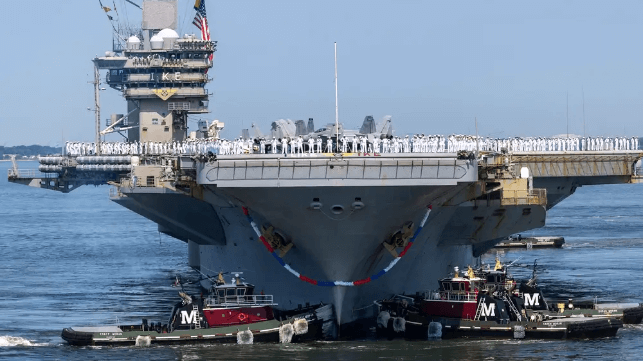Back From Historic Red Sea Mission, USS Eisenhower Gets Hero's Welcome

The carrier USS Dwight D. Eisenhower, her crew and her escorts have returned to Norfolk after what may be the U.S. Navy's most extended, concentrated battle at sea since the Second World War.
Navy aviators may have flown more combat missions over Korea, Vietnam, Iraq or Afghanistan, but the mission in the Red Sea is the first time in eight decades that the surface navy's ships and crews have faced daily attacks on their own vessels. Eisenhower and her crew received a hero's welcome when they pulled into Norfolk on Sunday, complete with a flyover and a welcoming committee on the pier.
"For nearly seven months, the Ike Carrier Strike Group delivered exceptional naval power, answering the call . . . to defend innocent civilian merchant mariners," said Navy Secretary Carlos Del Toro in a welcoming address. "Service to our country is fundamental to our democracy. Every Sailor and Marine who sailed as part the Eisenhower Carrier Strike Group chose to serve. By defending our ally Israel as well as innocent civilian merchant mariners against Iranian and Houthi attacks, they made an incredible impact that will forever be a part of our naval services’ legacy."
Eisenhower's aircraft and destroyers took down dozens of suicide drone aircraft, boats, uncrewed underwater vehicles and antiship missiles. In defending themselves and nearby merchant shipping from Iranian-backed Houthi attacks, Ike's escorts used up 155 Standard Missiles in an anti-aircraft role ($2-4 million each) and 135 Tomahawk land attack missiles for strikes on Houthi positions ($2 million each). The carrier's air wing expended about 60 air-to-air missiles ($400,000 to $1 million each) and launched or dropped 420 air-to-surface weapons. Along the way, Eisenhower's fighters performed the Navy's first ever air-to-air combat missions against unmanned drone aircraft.
Crewmembers aboard the destroyer escorts were sometimes able to watch within visual range as air defenses shot down incoming threats, officials have told defense press outlets. “It was very dynamic. It was something we really have not seen — for the carrier strike group to be that close to that kind of fight — since World War II. It has been a constant evolution,” air wing commander Capt. Marvin Scott told Stripes.
Navy leaders have quietly acknowledged that the long deployment within reach of Houthi missiles has had an effect on the strike group's sailors, and have prepared in advance to have extra support on hand for any personnel who might need counseling. In addition to the onboard team of four counselors and seven chaplains, the Navy sent over advance teams to talk with sailors and provide extra care before they reunited with loved ones.
Despite extensive efforts at suppression, the Houthi threat remains active, and the group continues to launch attacks on shipping. Over the weekend, American forces destroyed three Houthi drones on the ground in Yemen, two more over the Red Sea, and one suicide drone boat in the Red Sea.
To keep up this tempo, carrier USS Theodore Roosevelt diverted from a patrol in the Western Pacific to the Mideast in order to relieve USS Eisenhower. Roosevelt was reportedly in the U.S. Central Command area of operation as of Friday, several weeks after Eisenhower left the region. Meanwhile, sister ship USS Abraham Lincoln quietly left port in San Diego on Thursday to head for a deployment in the Pacific, backfilling for USS Roosevelt.
